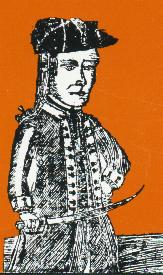

|


Shays' Rebellion

During the years 1786 and 1787, a series of confrontations took place between desperate debtor-farmers and state government authorities in western Massachusetts. The events that became known as Shays' Rebellion came to symbolize the widespread discontent manifested throughout New England during the economic depression that followed the American Revolution.
From 1781 until 1789, the United States was governed under a loose union of states called the Articles of Confederation. This government lacked the authority to regulate trade or to collect taxes. Although burgeoning public debt threatened the nation's credit, each state was responsible for paying its share of the staggering Revolutionary War debt. Merchants in eastern Massachusetts, anxious to pacify their foreign creditors, urged the state legislature to raise taxes to meet the debt.
These taxes, which had to be paid in cash, were particularly burdensome to farmers, who traditionally relied on barter to see them through hard times. Those hardest hit usually lacked the property qualifications for voting and thus were unable to influence the government through the ballot. Many lost their farms through foreclosure for overdue debts and delinquent taxes. Others faced debtors prison. Those debtors who were Revolutionary War veterans felt they had been betrayed.
In August, 1786, a group of 1500 farmers marched on Northampton to prevent the courts from hearing foreclosure proceedings. In September, an armed force led by Revolutionary War veteran Daniel Shays of Pelham closed the courthouse at Springfield. By January, 1787, the situation had become desperate. Daniel Shays led the main body of a large group of armed insurgents to confiscate arms an ammunition stored in the arsenal at Springfield. They were opposed by about 1200 militia under the command of General William Shepard. Shays advanced, expecting reinforcements that never came. When Shays refused to halt, Shepherd opened fire with small arms and artillery. The cannon fire routed Shays men, leaving twenty wounded and four dead.
Shays' men retreated to the Pelham Hills, where they were followed by four regiments of troops (raised and paid for by Boston and eastern Massachusetts merchants) under the command of General Benjamin Lincoln. After an all-night march through a howling snowstorm, Lincoln surprised Shays' men at Petersham, scattering the insurgents with artillery fire. Although sporadic resistance continued, Shays Rebellion was effectively over.
The Rebellion, however, left its mark. Reforms in line with Shays' demands were enacted after the next election turned his opponents out of office. But of larger significance, it put into sharp relief the crisis of government posed by the Articles of Confederation. To discontented farmers, the government seemed unresponsive to the will of the people. To merchants and creditors, the government seemed vulnerable to anarchy. Shays' Rebellion crystallized these issues precisely at the time when the states were choosing delegates to attend the convention that was to draft the Constitution of the United States.
Contents Historic Northampton.